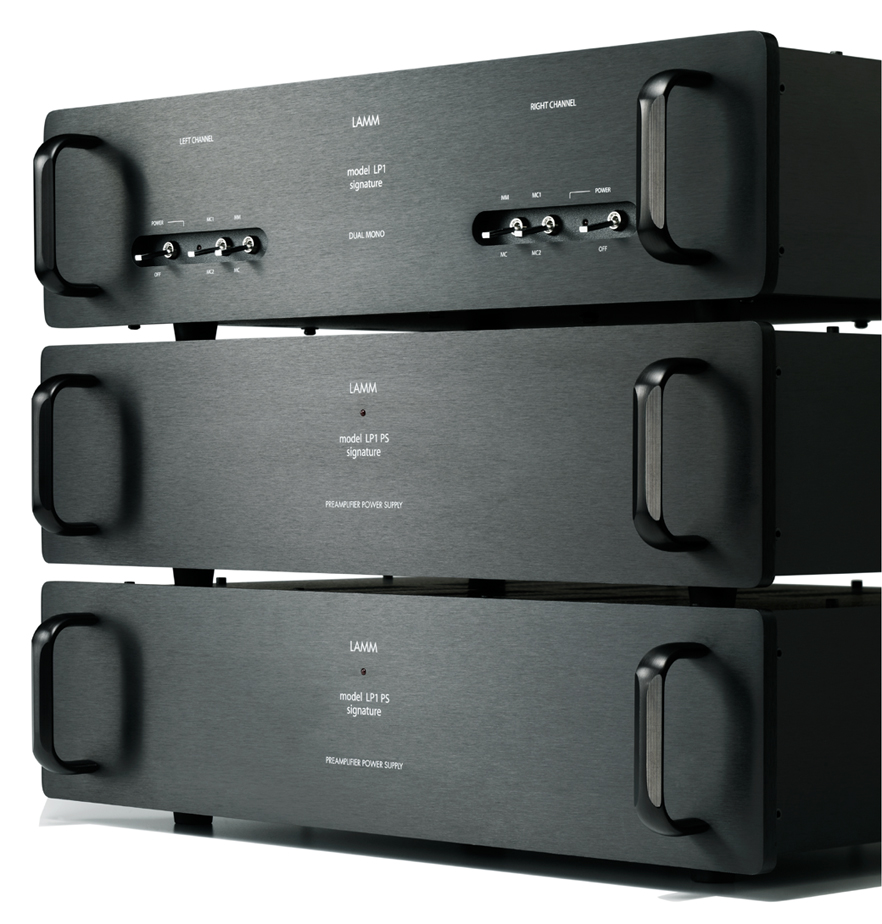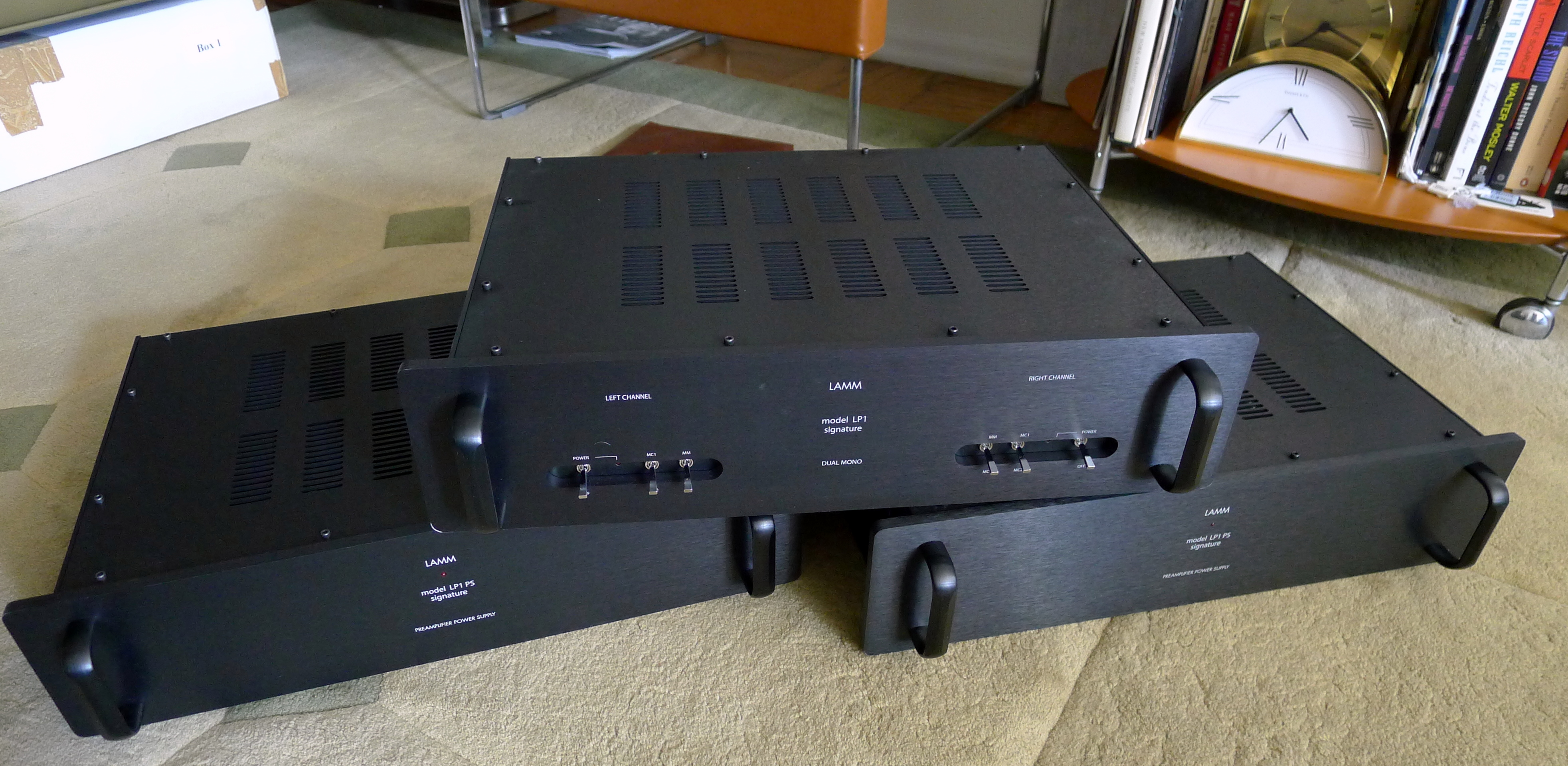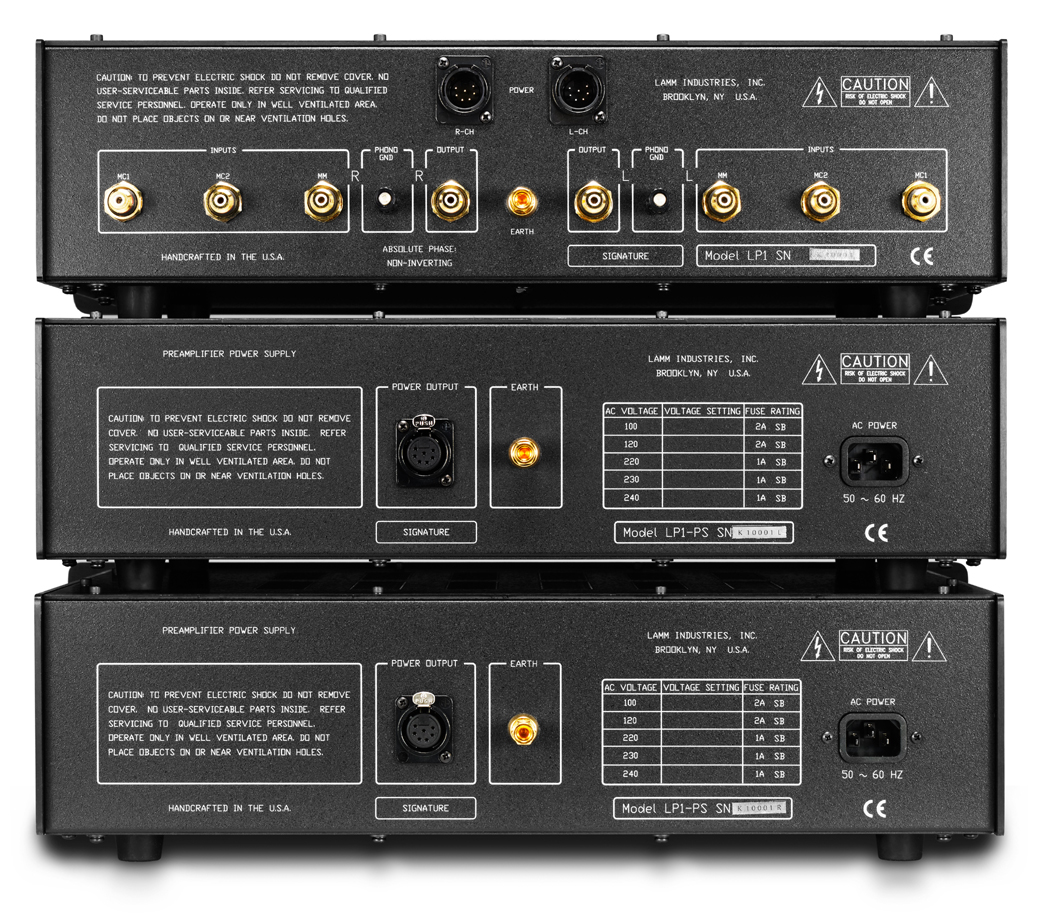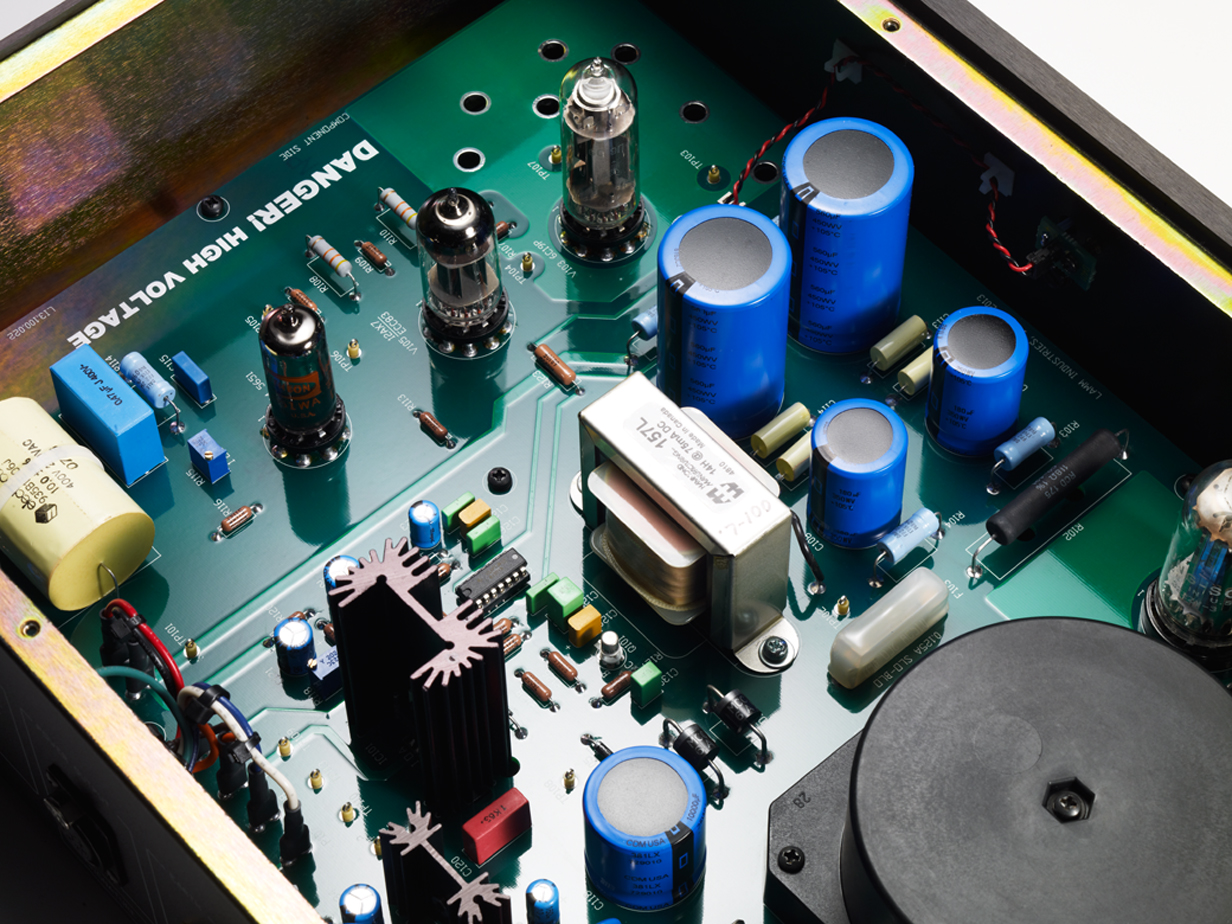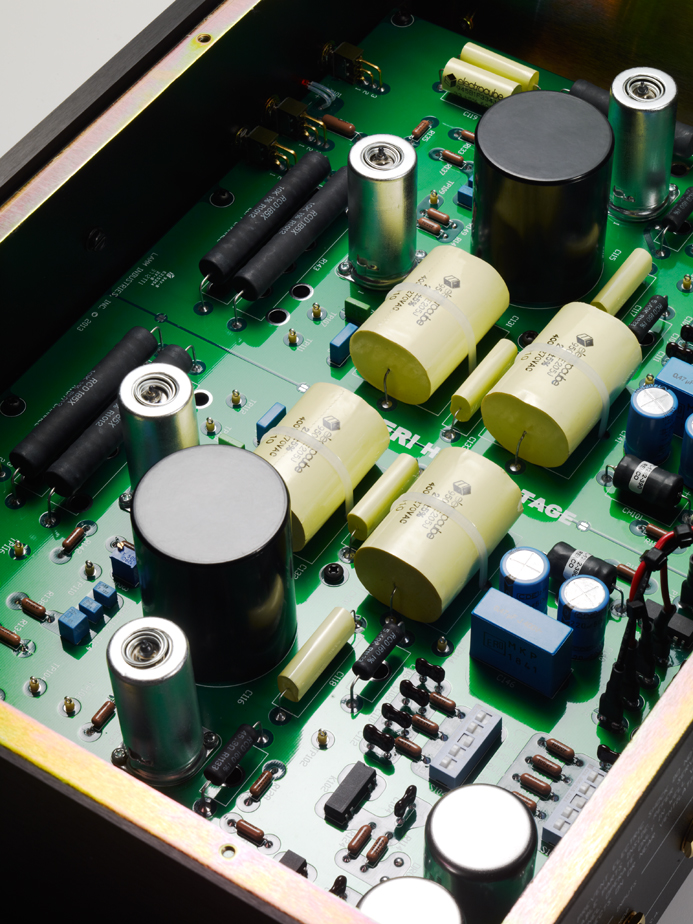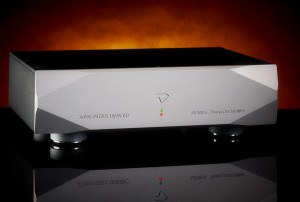Tempus Fugit but Some Things Stay the Same
Three nearly identical, "old school," black chassis took up position on my rack. It would be a stretch to call them eye candy—some visitors chided the pro audio cosmetics—yet the effect is nearly the same. The Lamm LP1 Signature Phono Preamplifier is an imposing sight that proclaims "This is a serious phono stage." Even before hearing it, listeners knew what they were looking at.
Lamm gear has always looked like this. The famous designer at the helm, Vladimir Lamm, is focused on performance, not an interior decorator's idea of home audio. He builds components that are cosmetically aligned with the pro world or the laboratory. As he states:
…high-end audio equipment should be a means for contact with music, not an eye-catching piece of furniture. Our money is invested into MAKING THE SOUND…
OK, enough already on the cosmetics. Let's move on to what's most important—the sound. In this regard, time has definitely not stood still. In significant ways, the LP1 Sig didn't conform to past impressions of Lamm products.
External Power Supplies and Control Unit
The most distinguishing feature of the LP1 Sig is its three chassis—an external power supply for each channel plus a control unit. Lamm offered this practical explanation: In a maxed-out design like the LP1, there were simply too many parts to fit in one or even two chassis. Then the question becomes, what does it buy you?
Nowadays, the external power supply has caught on; you might even say it's trending. Not long ago I had the opportunity to review the PAM G2 Phono Amplifier from Audionet, which offers three levels of power supplies. As we moved up through the levels each demonstrated clear improvements. In no small way, the exercise was eye opening. Only the power supply was in play. The actual circuitry processing the signal in the control unit never changed.
When we reached the top-of-the-line supply the difference was significant enough to be considered the next level product. In point of fact, I know of several well-respected brands where the difference between mid and reference level product is simply the power supply. (Along with the cosmetics—the higher MSRP models always sport more bling.)
What You Would Expect
Based on that experience with the Audionet PAM G2, I fantasized about the potential of an unrestrained power supply. It would obviously impart massive improvement in dynamics; total elimination of cross talk between the channels; and rock-solid soundstaging cues.
I also would expect transient response to benefit. Individual sounds should present themselves quickly and nicely, with less over- or undershooting. That is, impulse response would be closer to the hypothetical ideal.
Furthermore, I would expect a tighter, more tuneful low end. Being a fully tubed circuit, such gear is prone to uncontrolled resonances in the low end that make it sound fuller, but also looser. The power supply, if done right, should free the component of low-frequency resonance.
Beyond that, I would expect reduced edginess and greater depth of tone.
Bedrock Foundation
What I heard after the lengthy burn-in was no ordinary soundstage. (The LP1 gets three days at the factory; give it at least three more.) A massive, unshakable foundation was laid out in front of me. The images of the instruments were precisely positioned with such density and weight the presentation had the aspect of a large piece of aural sculpture. The effect was immensely impressive in audio terms—and immensely satisfying musically.
Sometimes I conceive of an instrument's sound as akin to the construction of a house. It begins with a foundation, which has to be as rigid as possible (typically cement and steel are used). Then floors are added, building upwards.
In a similar manner, one can conceive of the low-frequency harmonics comprising a foundation. The principal note value and the harmonic bouquet are stacked upon it. Everything rests on the low-frequency foundation. If it ain't firm, the entire structure is compromised.
Ideally all of the layers align, share characteristics, and assume the shape of a vertical column. The bottom doesn't bulge, the top doesn't taper, body is evenly apportioned, and transient behavior is the same throughout. If all of the layers align and behave similarly, the structure is able to navigate as a coherent object.
I hear this ideal column all the time in the best concert halls, but rarely in Hifi, because audio components capable of creating it are few and far between. The LP1 Sig does it to near perfection. The sole deviation is the low-frequency foundation, which is a bit oversized.
Not your Everyday Tube Sound
The stereotypical tube preamp has a zaftig, loose low end. I expected the maxed-out power supply to address this, and so it does. The LP1 defies the norm with a bottom that is taut and controlled. (That can be said of all frequencies. In the LP1, nothing is loose.) Consequently, the bass is able to move right in sync with the rest of the layers in our imaginary column.
While that larger bottom may be a deviation from linearity, it lends the LP1 massive authority. I'll take it over strict linearity any day.
One more thing about the weighty foundation. Sometimes a component can go overboard by imparting too much weight. Then the stage becomes muscle-bound and stiff, as if rigor mortis has set in. The instruments come to resemble tombstones and the stage becomes a graveyard. The LP1 Sig strikes a nice balance, providing a firm foundation while allowing the images to dance. And it always projects a musical, flowing line.
The Voice of Authority
As for the first item on my list of expectations—massive improvement in dynamics—the dual power supplies prime the pump to an almost frightening degree. When I play well-recorded vinyl through the LP1 Sig, the fortes burst into the room and achieve peaks beyond other units. Truly excellent, it never hit a ceiling, never flattened out, and there was virtually no sense of compression. Nor did it suffer any compromise in quality.
Turning to dynamics on the micro side, pianissimo passages are even softer and with more inner detail than my reference Allnic H-3000V. Dynamics are all about scale, the range between lows and highs, and the LP1 extends the range on both ends.
When you add up these strengths, I am reminded of the mighty powerhouse mbl Reference Line Monoblocks, the champions of slam. The LP1 similarly unleashes symphonic crescendos of tsunami proportions.
Needless to say, in my experience, previous Lamm products could not lay claim to anything like this.
Painting the Soundstage
I've been fortunate to have spent time with a bunch of Reference Class phono stages—the Audio Consulting, the Ypsilon, the Audionet, and the Merrill Audio Jens. Interestingly, they all paint their soundstage using a fine brush. Their images tend to be proportionally-sized, with sharp focus and firm borders. They appear in different locations, segregated from each other, sometimes in high relief.
The LP1 runs counter by employing a broad brush and even strokes, creating larger images with soft edges. The transient comes on fast enough, but with a soft edge. It happens in a highly naturalistic manner without calling attention to itself. The sound has plenty of POP, but individual instruments don't POP out, i.e. they don't come forward. The stage is smooth across its width. It may have trendsetting dynamics, but the sound is relaxed and so is the listener.
Ease of Delivery
The tubed Allnic H-3000V is similar. It is all smooth edges with no sharp corners and paints with a broad brush and even strokes. The Allnic's strengths are naturalism and great musical flow. It takes listener ease to the next level.
However, should you A/B the LP1 close in time with the Allnic, you realize how bloomy, warm and not neutral the Allnic is. In the things that count, the LP1 ups the ante. Tonally warm, dense, and a bit dark, the LP1 makes the Allnic sound light. Yes, the LP1 is a tad sweet, but much closer to neutral. You'll find its timbres fully realized and true to the instrument. And as with anything Lamm, coherency and integration are strong points.
The Allnic, which I considered a Best Buy at $15K, is humbled by the comparison.
Installation
Installation is straight forward. Each power supply gets its own power cord and connects to the control unit with a provided umbilical. All three chassis generate a fair amount of heat, so allow adequate ventilation. Put them on separate shelves with at least 3" of clearance above. On a daily basis, I gave the LP1 a minimum of 45 minutes with signal before sitting down for serious listening.
Grounding Options
The LP1 Sig provides many options for grounding. I simply attached the turntable ground wire to the post labelled EARTH on the control unit and had no problem. In the event you run into noise issues, there is also a post labelled PHONO GND on either side on the back of the control unit. These can be connected to a post on each power supply (labeled EARTH).
Important note: for optimum sound quality, take care that both power supplies and the turntable motor are plugged into the same wall outlet.
Usage and Features
The LP1 is a very purist device, determinedly dual-mono from input to output. Look at the user interface. You would think there'd be a single On/Off power switch, like most components. Nope. All of the switches are replicated left/right—every last one has a symmetrical partner. The control unit only supports RCA Ins/Outs—there is no provision for XLR.
The control unit is a single-ended, vacuum triode phono preamplifier employing high current pure class A operation from input to output. No loop feedback is employed.
There are two inputs for moving-coil cartridges and one for moving-magnet. The one labelled MC1 has 71dB of gain and is set to 30-ohm input impedance: it is intended for very-low-output cartridges. MC2 provides 60dB of gain and 430 ohms input impedance for medium output MC cartridges. Each MC input has a dedicated step-up transformer.
From the website, other features include:
- Audibly neutral power supplies (one for each channel) featuring full-wave vacuum rectifiers, choke contained filters, vacuum tube high-voltage regulators, and solid-state low-voltage analogue non-switching regulators used as the heater supplies
- All amplification stages utilize high transconductance, super low noise, high-current vacuum triodes
- Very accurate RIAA EQ network
I was curious as to why the LP1 Sig eschews the usual gain and loading adjustment provisions found on most phono preamps. In a telephone interview, Vladimir told me that, based on his empirical testing, exact matching of impedance—the ability to choose among five, or ten, input impedances—is not critical. All medium output MC cartridges will work just fine with MC2; 99% of low-output MCs will be happy with MC1. For practical purposes, there is no need to make adjustments if you swap brands or replace your MC cartridge. (For the 1% of cartridges with very low output some adjustments may be required; check the manual or talk to your dealer.)
One small note: I wanted to use the Stage III Analord Master Phono Cable, but ran into an ergonomic snag. The Lamm's phono inputs are on either end on the back of the chassis, too far apart for the leads from the Analord Master to span the distance between them.
Conclusion
Want to hear your LPs like it's the first time again? Those moments came often enough with the Lamm LP1 Signature in line. It opened up the score and exposed instrumental parts I had not identified previously. Favorite discs were suddenly not so familiar.
Did you know there's a wind machine midway into Mussorgsky's "Night On Bald Mountain" (The Power of the Orchestra, Chesky reissue RC30)? I had heard something like one before, but I was never quite sure what it was. I think there may actually be two. (There are many versions of the score—seems everybody took a crack at orchestrating it.)
The LP1 with its three chassis brought incredible foundation and heft to those old chestnuts. This is something new as I've never associated Lamm with slam. Yet, for all its authority, the LP1 is so comfortable on the ear. As I said above, the sound has plenty of POP, but individual instruments don't POP out and come forward.
For a reviewer, the upgrade process never stops. During the course of the evaluation, I changed a few wires and had my cartridge re-aligned. The LP1 scaled to the quality of each upgrade and impressed anew, which makes me think I hadn't tested its limits in my rig.
The Lamm LP1 Signature does so many things right—without question it has to be considered among the world's great phono preamps. It should find a home in the very best systems.
Lamm LP1 Signature Phono Preamplifier
Retail: $36,790 USD
Specifications
VOLTAGE GAIN
at F = 1 KHz: typically 70 dB (MC1): typically 60 db (MC2), typically 40 dB (MM)
INPUT IMPEDANCE
at F = 1 KHz: typically 31.5 Ohms (MC1), typically 430 Ohms (MC2), typically 47 KOhms shunted by 200 pF (MM), standard factory adjustment
MM IMPEDANCE
setting (internally adjusted): 100 Ohms, 10 KOhms, 47 KOhms, 75 KOhms, 100 KOhms
MM CAPACITANCE
setting (internally adjusted) 100 pF, 150 pF, 200 pF, 300 pF, 400 pF
CORRECTED OUTPUT IMPEDANCE
typically 1.5 KOhms
PHONO OVERLOAD
F = 1 KHz: typically 8.0 mV RMS (MC1), typically 40.0 mV RMS (MC2), typically 400.0 mV RMS (MM)
Signal-to-noise ratio: below 1 Volt RMS output, A weighted: MC1 input to output (shorted input) better than 78dB, MC2 input to output (shorted input) better than 79.5dB, MM input to output (shorted input) better than 81.5dB
ABSOLUTE PHASE
non-inverting
POWER CONSUMPTION
170 Watts
BURN-IN TIME AT FACTORY
minimum 72 hours
RECOMMENDED BURN-IN TIME IN END-USER'S SYSTEM
minimum 160 hours
WARM-UP TIME
minimum 30 minutes
WEIGHT, UNIT ONLY
Preamplifier 36.8 Lbs (16.7Kg)
Power supply 20.7 Lbs (9.4 Kg), each
SHIPPING WEIGHT
Preamplifier 54.8 Lbs (24.9Kg)
Power supply 38.7 Lbs (17.6 Kg), each.
TUBE COMPLEMENT
Preamplifier V101 – 6C3P (left channel, first amplification stage), V102 – 6C3P (right channel, first amplification stage), V103 – 6C45P-E (left channel, second amplification stage), V104 – 6C45P-E (right channel, second amplification stage)
Power supply V101, V102 – 12AX3/12BE3 rectifier tubes, V103 – 6C19P, voltage regulator tube, V104 – 5651A, voltage reference tube, V105 - 12AX7/ECC83, voltage regulator tube
Lamm Industries, Inc.
2513 East 21 Street
Brooklyn, NY 11235
+1.718.368.0181 tel.
+1.718.368.0140 fax




